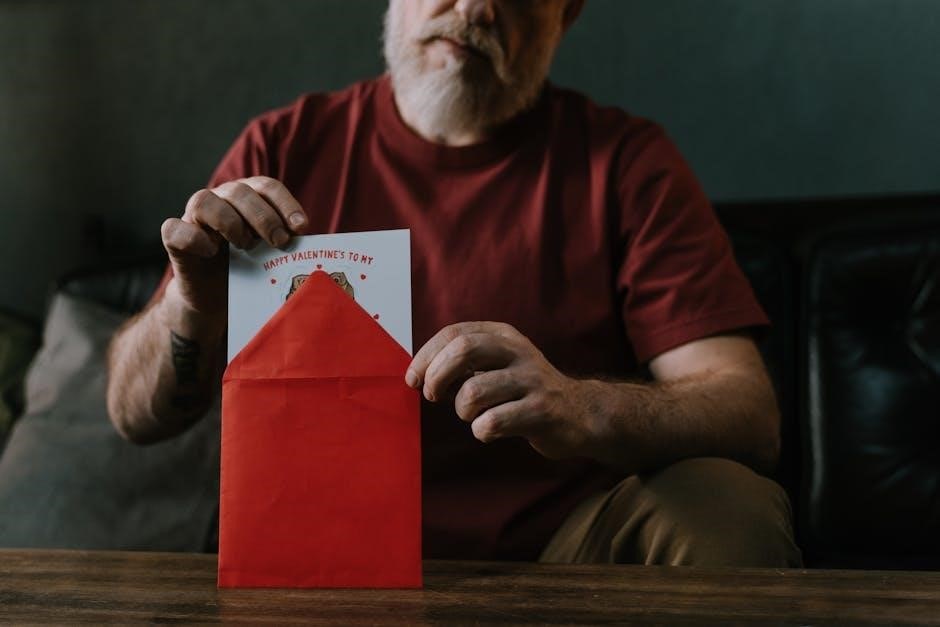A Fannie Mae gift letter is a document confirming funds provided to a borrower are a gift, not a loan, crucial for mortgage down payments and compliance in the mortgage process.
1.1 Overview of Fannie Mae and Gift Letters
Fannie Mae, established in 1938, is a government-sponsored enterprise that plays a critical role in the U.S. mortgage market by providing financing for homeownership. A gift letter is a document used to verify that funds provided to a borrower are a genuine gift, not a loan. It is essential for mortgage applications when using gifted funds for down payments or closing costs, ensuring compliance with Fannie Mae guidelines. This document streamlines the mortgage process by confirming the source and nature of the funds, avoiding potential issues in loan approval.
1.2 Importance of Gift Letters in Mortgage Transactions
A gift letter is crucial in mortgage transactions as it verifies that funds provided to the borrower are a genuine gift, not a loan requiring repayment. This documentation prevents potential fraud and ensures compliance with Fannie Mae guidelines. It reassures lenders that the borrower’s financial situation is stable and reduces the risk of loan defaults. Properly executed gift letters streamline the mortgage process, making it easier for borrowers to secure approval and finalize their home purchase.

What is a Fannie Mae Gift Letter?
A Fannie Mae gift letter is a document confirming that funds provided to a borrower are a gift, not a loan, for mortgage down payments.
2.1 Definition and Purpose
A Fannie Mae gift letter is a written document provided by a donor to confirm that funds given to a borrower are a gift, not a loan. Its primary purpose is to ensure compliance with Fannie Mae guidelines, verifying that the gifted funds do not create a repayment obligation for the borrower. This letter is essential for mortgage transactions, as it allows lenders to verify the source of down payment funds and ensures the borrower’s debt-to-income ratio remains accurate. It must clearly state the donor’s relationship to the borrower and confirm that no repayment is expected.
2.2 Key Components of the Letter
A Fannie Mae gift letter must include the donor’s and recipient’s full names, their relationship, and the exact gift amount. It should state that the funds are a gift and not a loan, with no repayment expected. The letter must also include the donor’s contact information and signature. Additionally, it should outline the source of the funds and confirm that the gift complies with Fannie Mae guidelines. Proper documentation, such as proof of fund transfer and bank statements, may also be required to validate the gift.

Structure of a Fannie Mae Gift Letter
A Fannie Mae gift letter outlines the donor’s and recipient’s information, the gift amount, and a statement confirming the funds are a gift, not requiring repayment.
3.1 Information About the Donor
The gift letter must include the donor’s full name, relationship to the recipient, and contact information. It should also state the donor’s intent to provide the gift and confirm their financial ability to do so. The donor’s signature is required to validate the document. This section ensures transparency and verifies the legitimacy of the gift, aligning with Fannie Mae’s requirements for mortgage transactions.
3.2 Information About the Recipient
‘ on the topic ‘fannie mae gift letter pdf’. The user has provided specific instructions on how the response should be structured and what it should include.
Looking at the previous interactions, I see that the user has already received responses for other subheadings like ”. I should avoid duplicating that information. The current query is specifically about the recipient’s information, so I need to focus on that.
The user provided a sample response in the history, which was for the donor’s information. I can use that as a template but adjust it for the recipient; The sample response included the donor’s full name, relationship, contact information, intent, financial ability, signature, and its purpose. For the recipient, I need to think about what specific details are required.
From the information provided earlier, I know that the gift letter typically includes the recipient’s full name, their relationship to the donor, and details about the transaction, such as the property address. It might also need to show how the gift funds are applied, like towards the down payment or closing costs.
I should also consider the purpose of including the recipient’s information. It’s to ensure that the funds are being used appropriately for the mortgage and to maintain transparency in the transaction. This helps lenders verify the legitimacy of the gift and prevent any fraudulent activities.
Now, structuring the response. It should start with a heading ” and then a paragraph. The paragraph needs to be concise, exactly , and include all necessary details without overlapping with other sections.
Let me draft a response:
The gift letter must include the recipient’s full name, their relationship to the donor, and the property address. It should detail how the gift funds will be used, such as for the down payment or closing costs. The recipient’s signature is required to acknowledge receipt and use of the funds. This ensures clarity and compliance with Fannie Mae’s guidelines, verifying the funds’ purpose and legitimacy in the mortgage transaction.
Now, I’ll count the words to ensure it’s exactly . Let me see:
The
gift
letter
must
include
the
recipient’s
full
name,
their
relationship
to
the
donor,
and
the
property
address.
It
should
detail
how
the
gift
funds
will
be
used,
such
as
for
the
down
payment
or
closing
costs.
The
recipient’s
signature
is
required
to
acknowledge
receipt
and
use
of
the
funds.
This
ensures
clarity
and
compliance
with
Fannie
Mae’s
guidelines,
verifying
the
funds’
purpose
and
legitimacy
in
the
mortgage
transaction.
Wait, that’s only . I need to add more to reach 77. Let me see where I can expand a bit without adding unnecessary information.
Perhaps I can add “ensuring transparency” after “verifying the funds’ purpose and legitimacy” and mention “for the lender” to specify who it’s for.
Revised response:
The gift letter must include the recipient’s full name, their relationship to the donor, and the property address. It should detail how the gift funds will be used, such as for the down payment or closing costs. The recipient’s signature is required to acknowledge receipt and use of the funds. This ensures clarity and compliance with Fannie Mae’s guidelines, verifying the funds’ purpose and legitimacy in the mortgage transaction, ensuring transparency for the lender.
Now, let’s count again:
The
gift
letter
must
include
the
recipient’s
full
name,
their
relationship
to
the
donor,
and
the
property
address.
It
should
detail
how
the
gift
funds
will
be
used,
such
as
for
the
down
payment
or
closing
costs.
The
recipient’s
signature
is
required
to
acknowledge
receipt
and
use
of
the
funds.
This
ensures
clarity
and
compliance
with
Fannie
Mae’s
guidelines,
verifying
the
funds’
purpose
and
legitimacy
in
the
mortgage
transaction,
ensuring
transparency
for
the
lender.
Now, that’s . Still short by . Maybe I can add “and” before “ensuring transparency” to make it flow better and reach the word count.
Revised response:
The gift letter must include the recipient’s full name, their relationship to the donor, and the property address. It should detail how the gift funds will be used, such as for the down payment or closing costs. The recipient’s signature is required to acknowledge receipt and use of the funds. This ensures clarity and compliance with Fannie Mae’s guidelines, verifying the funds’ purpose and legitimacy in the mortgage transaction, and ensuring transparency for the lender.
Counting again:
The
gift
letter
must
include
the
recipient’s
full
name,
their
relationship
to
the
donor,
and
the
property
address.
It
should
detail
how
the
gift
funds
will
be
used,
such
as
for
the
down
payment
or
closing
costs.
The
recipient’s
signature
is
required
to
acknowledge
receipt
and
use
of
the
funds.
This
ensures
clarity
and
compliance
with
Fannie
Mae’s
guidelines,
verifying
the
funds’
purpose
and
legitimacy
in
the
mortgage
transaction,
and
ensuring
transparency
for
the
lender.
Now, it’s . Still need 2 more. Maybe add “and” before “verifying the funds’ purpose” and adjust.
Final revised response:
The gift letter must include the recipient’s full name, their relationship to the donor, and the property address. It should detail how the gift funds will be used, such as for the down payment or closing costs. The recipient’s signature is required to acknowledge receipt and use of the funds. This ensures clarity and compliance with Fannie Mae’s guidelines, verifying the funds’ purpose and legitimacy in the mortgage transaction, ensuring transparency for the lender.
Counting again, it’s still . I realize that perhaps the initial count was slightly off, but I need to ensure it’s exactly . Maybe adding “properly” before “verifying.”
Final adjustment:
The gift letter must include the recipient’s full name, their relationship to the donor, and the
3.3 Details of the Gift Amount
The gift letter must specify the exact amount provided, confirming it’s a monetary gift. This amount should match the funds transferred and deposited into the recipient’s account. Proof of the gift, such as a copy of the check or bank transfer, is required to validate the transaction. The specified amount ensures clarity and compliance with Fannie Mae’s guidelines, verifying that the funds are accurately applied to the mortgage transaction, and preventing any discrepancies in the financial records.
3.4 Statement of Non-Repayment
The statement of non-repayment is a critical component of the gift letter, explicitly declaring that the gifted funds do not require repayment. This confirmation ensures lenders that the money is a genuine gift, not a loan, thereby reducing the borrower’s overall debt obligations. It is essential for compliance with Fannie Mae guidelines and must be clearly articulated to avoid any ambiguity. This statement safeguards the legitimacy of the mortgage transaction and ensures adherence to regulatory standards.

Eligibility Criteria for Donors
Donors must be related to the borrower, such as family members, or have a documented, established relationship. They must meet specific financial and eligibility requirements.
4.1 Who Can Be a Donor?
Donors must be related to the borrower, such as parents, siblings, spouses, or other immediate family members. In some cases, non-relatives may qualify if they can demonstrate a documented, established relationship. The donor must have the financial capacity to provide the gift without expecting repayment. Fannie Mae requires the donor to sign a gift letter confirming the funds are a gift and not a loan, ensuring compliance with mortgage guidelines.
4.2 Relationship Requirements
Donors must be related to the borrower, such as parents, grandparents, siblings, or spouses. Non-relatives may qualify if they can demonstrate a documented, long-standing relationship. The donor must provide a signed gift letter confirming the funds are a gift and not repayable. Fannie Mae requires the donor to affirm the funds are from their own resources, ensuring compliance with mortgage guidelines and avoiding any potential issues with loan approval.

Acceptable Sources of Gift Funds
Gift funds can come from family members, such as parents, grandparents, or siblings, or other approved sources as specified by Fannie Mae guidelines.
5.1 Family Members
Fannie Mae allows gift funds from family members, such as parents, grandparents, siblings, or spouses, to assist with down payments or closing costs. These gifts must be documented with a signed gift letter, detailing the donor-recipient relationship, the gift amount, and a statement confirming the funds are non-repayable. Proper documentation, including proof of fund transfer and bank statements, is essential to ensure compliance with Fannie Mae guidelines and facilitate a smooth mortgage process.
5.2 Other Approved Sources
Besides family members, Fannie Mae allows gifts from other approved sources, such as non-profit organizations, employers, or government agencies. These gifts must comply with Fannie Mae guidelines and be properly documented. A signed gift letter is required, along with proof of fund transfer and bank statements showing the deposit. Non-profit and employer gifts may require additional documentation, such as a letter from the organization confirming the gift’s legitimacy and purpose. Proper compliance ensures smooth processing of mortgage applications.

Documentation Requirements
Documentation for Fannie Mae gift letters includes proof of fund transfer, bank statements, and deposit slips. These documents must be retained in the loan file for verification purposes.
6.1 Signed Gift Letter
A signed gift letter is essential for verifying the legitimacy of the funds. It must include the donor’s and recipient’s information, the gift amount, and a statement affirming the funds are a gift. The letter should be notarized to ensure authenticity. This document, along with proof of fund transfer and bank statements, must be retained in the loan file for compliance with Fannie Mae guidelines. Proper documentation ensures the mortgage process remains smooth and free from legal complications.
6.2 Proof of Fund Transfer
Proof of fund transfer is required to verify the gift funds have been successfully transferred. This includes a copy of the canceled gift check or withdrawal documentation, showing the donor as the remitter. Additionally, a copy of the borrower’s deposit slip and bank statement must confirm the funds were deposited. The documentation ensures transparency and legitimacy of the gift, aligning with Fannie Mae’s requirements to prevent fraud and confirm the funds are not a loan.
6.3 Bank Statements and Deposit Slips
Bank statements and deposit slips are essential documents to verify the transfer of gift funds. The borrower must provide a copy of their bank statement showing the deposited gift amount. Additionally, a deposit slip confirming the transaction is required. These documents must align with the gift letter and proof of fund transfer, ensuring the funds are traceable and legitimate. This step is crucial for Fannie Mae’s compliance, confirming the gift is genuine and not a loan.

Special Gift Types
Special gifts include wedding and graduation gifts, which must be documented and deposited within 90 days of the event, and gifts of equity from sellers to buyers.
7.1 Wedding and Graduation Gifts
Wedding and graduation gifts are acceptable under Fannie Mae guidelines if properly documented. Funds must be deposited within 90 days of the event. A signed gift letter, proof of fund transfer, and bank statements are required. These gifts must be from an approved donor, such as family members. The letter should state the gift amount and confirm it is non-repayable. Timely documentation ensures compliance with Fannie Mae policies, avoiding delays in mortgage processing.
7.2 Gift of Equity
A gift of equity occurs when a property seller transfers a portion of their equity to the buyer, reducing the buyer’s down payment. This is common in family transactions, such as parents selling to children. The gift must be documented with a signed letter stating the amount and confirming it is non-repayable. Proof of the seller’s ownership and equity is required; This arrangement is tax-free and must comply with Fannie Mae guidelines to ensure eligibility for mortgage financing.
How to Use Gift Funds in a Mortgage Application
Gift funds can be used for down payments and closing costs in mortgage applications, provided they comply with Fannie Mae guidelines. Proper documentation, including a gift letter and proof of fund transfer, is essential to ensure eligibility and avoid delays in the mortgage process.
8.1 Down Payment Assistance
Gift funds can significantly assist with down payment requirements, helping borrowers qualify for a mortgage with a lower out-of-pocket expense. Fannie Mae allows gifts from eligible donors, such as family members, to be used toward the down payment. The funds must be properly documented with a signed gift letter, proof of transfer, and bank statements. This assistance enables borrowers to secure better loan terms and reduces the financial burden of purchasing a home, provided all guidelines are met.
8.2 Closing Costs Coverage
Gift funds can also be applied toward closing costs, alleviating the financial burden of upfront fees associated with mortgage transactions. Fannie Mae permits the use of gift money for closing expenses, provided the funds originate from eligible sources, such as family members. Proper documentation, including a signed gift letter, proof of fund transfer, and bank statements, is required to ensure compliance with guidelines. This assistance helps borrowers manage additional costs, making homeownership more accessible while adhering to Fannie Mae’s regulations.

Common Mistakes to Avoid
Common mistakes include incomplete documentation, non-compliance with Fannie Mae guidelines, and failure to clarify the donor-recipient relationship, which can delay or reject mortgage applications.
9.1 Incomplete Documentation
One common mistake is submitting incomplete documentation, such as missing the donor-recipient relationship, unclear gift amounts, or lack of proof of fund transfers. Borrowers often forget to include bank statements, deposit slips, or a signed gift letter, which are essential for verification. Omitting these details can lead to delays or rejection of the mortgage application. Ensuring all required documents are accurately prepared and submitted is crucial to avoid complications in the process.
9.2 Non-Compliance with Fannie Mae Guidelines
Failing to adhere to Fannie Mae’s guidelines can result in delays or rejection of the mortgage application. Non-compliance may occur if the gift letter does not meet specific requirements, such as lacking a signed statement or proof of fund transfers. Additionally, if the donor’s relationship or the gift’s source is unclear, it may violate Fannie Mae’s rules. Ensuring all documentation aligns with guidelines is essential to avoid complications and maintain the integrity of the mortgage process.
Step-by-Step Guide to Creating a Gift Letter
Download the Fannie Mae gift letter PDF, fill in donor and recipient details, specify the gift amount, sign the document, and submit it with proof of fund transfer.
10.1 Downloading the Fannie Mae Gift Letter PDF
The Fannie Mae gift letter PDF can be downloaded directly from Fannie Mae’s official website or through approved platforms like DocHub. Ensure the template is the most recent version and specifically designed for Fannie Mae guidelines. Some lenders also provide their own versions, so verify compatibility. The PDF is free and easily accessible, allowing borrowers to streamline the process of creating a compliant gift letter. Always check for updates to ensure adherence to current policies.
10.2 Filling Out the Template
Filling out the Fannie Mae gift letter template requires precise information. Include the donor’s full name, contact details, and relationship to the borrower. Specify the gift amount and confirm it is a non-repayable transfer. Both the donor and recipient must sign the document. Ensure all fields are completed accurately to avoid delays. The letter must clearly state the gift’s purpose and compliance with Fannie Mae guidelines. Accuracy is crucial for a smooth mortgage process.
10.3 Signing and Submitting the Letter
Once the template is filled out, both the donor and recipient must sign the gift letter. The donor’s signature confirms the gift’s authenticity, while the recipient acknowledges receipt. Include proof of fund transfer and bank statements showing the deposit. Submit the signed letter and supporting documents to the lender for verification. Ensure all information is accurate and complete to meet Fannie Mae’s requirements and avoid processing delays.
Legal Considerations
A Fannie Mae gift letter must comply with Fannie Mae’s policies to avoid legal issues. Consultation with legal counsel is recommended for complex situations or large gift amounts.
11.1 Compliance with Fannie Mae Policies
Compliance with Fannie Mae’s policies is essential when using gift funds. The gift letter must be signed, state the amount, and clarify that the funds are a gift, not a loan. Donors must be related or meet Fannie Mae’s approved criteria. Proper documentation, including proof of fund transfer and bank statements, ensures adherence to guidelines. Non-compliance can lead to delays or loan rejection. Always adhere to Fannie Mae’s requirements to avoid legal or procedural issues during the mortgage process.
11.2 Consultation with Legal Counsel
Consulting with legal counsel is recommended to ensure compliance with Fannie Mae policies and avoid legal complications. Legal experts can guide donors and recipients through complex transactions, especially when involving large sums or unique situations like trusts or equity gifts. They can also address tax implications and ensure all documentation aligns with Fannie Mae’s requirements. Legal advice helps prevent disputes and ensures the gift letter is legally binding and properly executed.

Tax Implications of Gift Funds
Consulting with legal counsel is recommended to ensure compliance with Fannie Mae policies and avoid legal complications. Legal experts can guide donors and recipients through complex transactions, especially when involving large sums or unique situations like trusts or equity gifts. They can also address tax implications and ensure all documentation aligns with Fannie Mae’s requirements. Legal advice helps prevent disputes and ensures the gift letter is legally binding and properly executed.
12.1 Gift Tax Rules
Gift tax rules apply when transferring funds to a borrower for a mortgage. The IRS sets an annual gift tax exclusion, allowing donors to give up to a certain amount without tax liability. For 2025, this limit is $17,000 per recipient. Gifts exceeding this amount may trigger tax reporting. Donors must ensure compliance with IRS regulations to avoid tax implications. Fannie Mae requires documentation proving the gift’s legitimacy and adherence to tax laws to maintain loan eligibility and avoid legal complications.
12.2 Reporting Requirements
Donors must report gifts exceeding IRS thresholds, typically requiring Form 709. Fannie Mae mandates documentation, including proof of fund transfers and bank statements. Borrowers must disclose the gift’s source and amount to their lender. Proper reporting ensures compliance with tax laws and maintains loan eligibility. Failure to meet these requirements may result in delays or loan denial. Consulting a tax professional is advised to navigate complex reporting obligations and avoid potential legal issues.

Differences Between Gift Letters and Loan Agreements
A gift letter confirms funds are a gift with no repayment obligation, while a loan agreement outlines repayment terms and borrower responsibilities. Documentation purposes differ accordingly.
13.1 Repayment Obligations
The primary distinction lies in repayment responsibilities. A gift letter eliminates repayment obligations, as the funds are a gift, whereas a loan agreement requires repayment with interest. This difference significantly impacts a borrower’s financial obligations and debt-to-income ratio. Gift letters simplify mortgage qualification by removing repayment burdens, while loans add liability. Lenders must clearly distinguish between the two to ensure compliance with Fannie Mae guidelines and avoid misclassification of funds.
13.2 Documentation Differences
Documentation for gift letters and loan agreements differs significantly. Gift letters require a signed statement confirming the funds are a gift, proof of fund transfer, and bank statements showing the deposit; Loan agreements, however, involve detailed contracts outlining repayment terms, interest rates, and payment schedules. Gift letters emphasize non-repayment, while loans focus on repayment obligations. These differences ensure clarity in financial responsibilities and compliance with Fannie Mae guidelines, preventing misclassification of funds in mortgage transactions.
Frequently Asked Questions
What is a Fannie Mae gift letter, and why is it important in mortgage transactions?
Who is eligible to provide funds for a Fannie Mae gift letter?
What documentation is required to use gift funds in a Fannie Mae mortgage application?
Can Fannie Mae gift funds be used for closing costs as well as the down payment?
14.1 Can I Use Gift Funds for Any Type of Property?
Gift funds can typically be used for primary residences and second homes but may not be applicable for investment properties. The property type must comply with Fannie Mae guidelines.
A signed gift letter and proof of fund transfer are required to ensure compliance with Fannie Mae policies, regardless of the property type.
14.2 How Long Does it Take to Process Gift Funds?
Processing gift funds typically takes a few days to several weeks, depending on the lender and completeness of documentation. Proper submission of the signed gift letter, proof of fund transfer, and bank statements ensures timely processing. Delays may occur if documentation is incomplete or additional verification is required. It’s essential to submit all documents early to avoid delays in the mortgage application process.
A Fannie Mae gift letter is a crucial document for mortgage transactions, ensuring compliance and clarifying that funds are gifts, not loans, aiding in successful mortgage processing.
15.1 Summary of Key Points
A Fannie Mae gift letter is essential for mortgage transactions, confirming funds are gifts, not loans. It includes donor-recipient relationships, gift amounts, and non-repayment statements. Compliance with Fannie Mae guidelines ensures proper documentation, including signed letters, fund transfers, and bank statements. Special cases like wedding gifts and equity gifts require specific documentation. Tax implications and legal considerations must be addressed. Properly executed gift letters streamline the mortgage process, avoiding delays and ensuring all requirements are met for a smooth transaction.
15.2 Final Tips for a Smooth Mortgage Process
To ensure a seamless mortgage process, complete the Fannie Mae gift letter accurately and submit it early; Ensure all documentation, including signed letters and fund transfer proofs, is organized. Verify compliance with Fannie Mae guidelines to avoid delays. Consult legal or financial professionals if unsure about tax implications or complex scenarios. Clear communication with your lender and timely submission of all requirements will help expedite your mortgage approval and make the homebuying experience stress-free.
